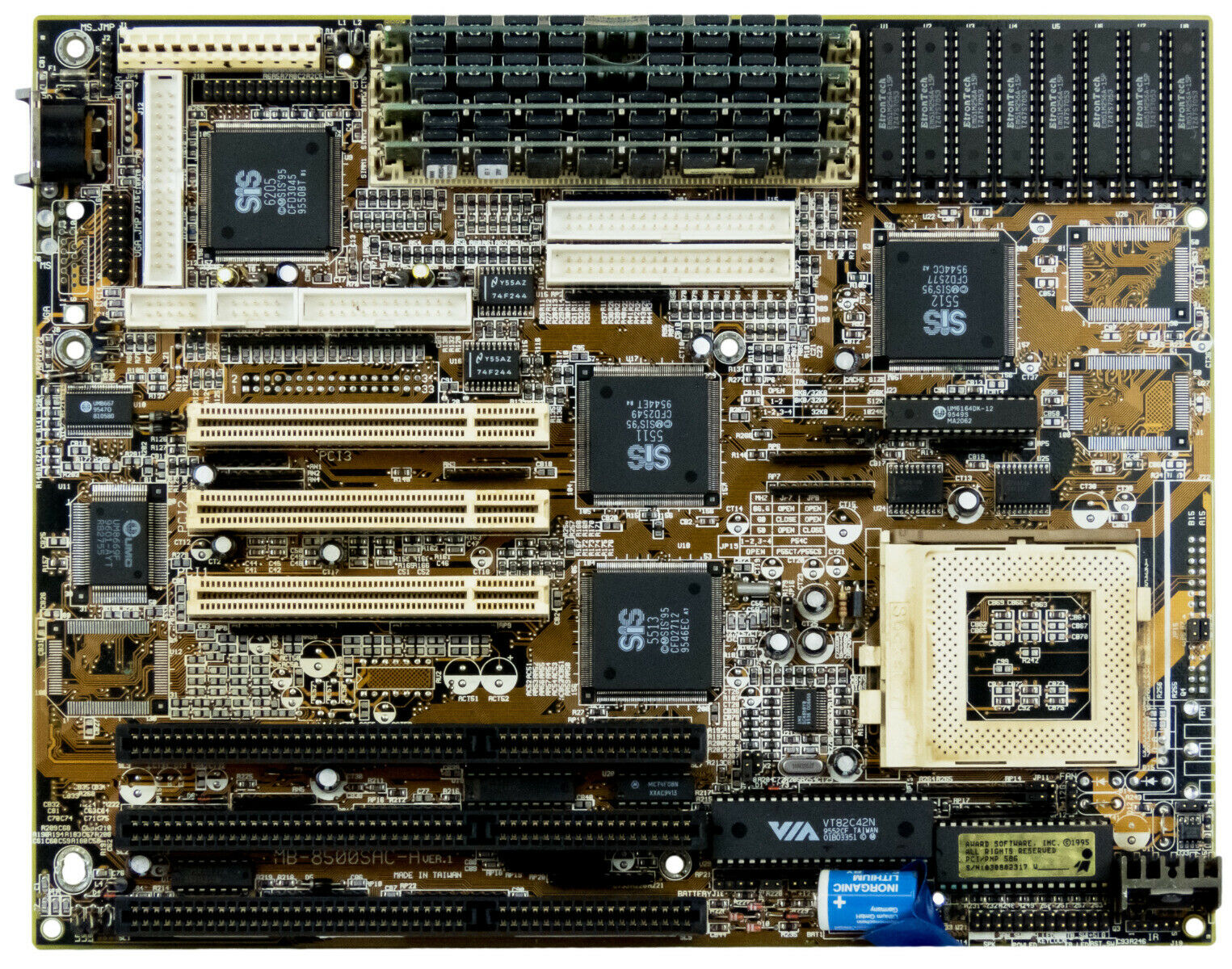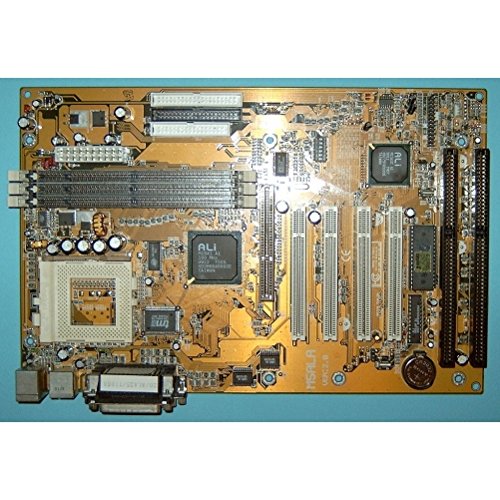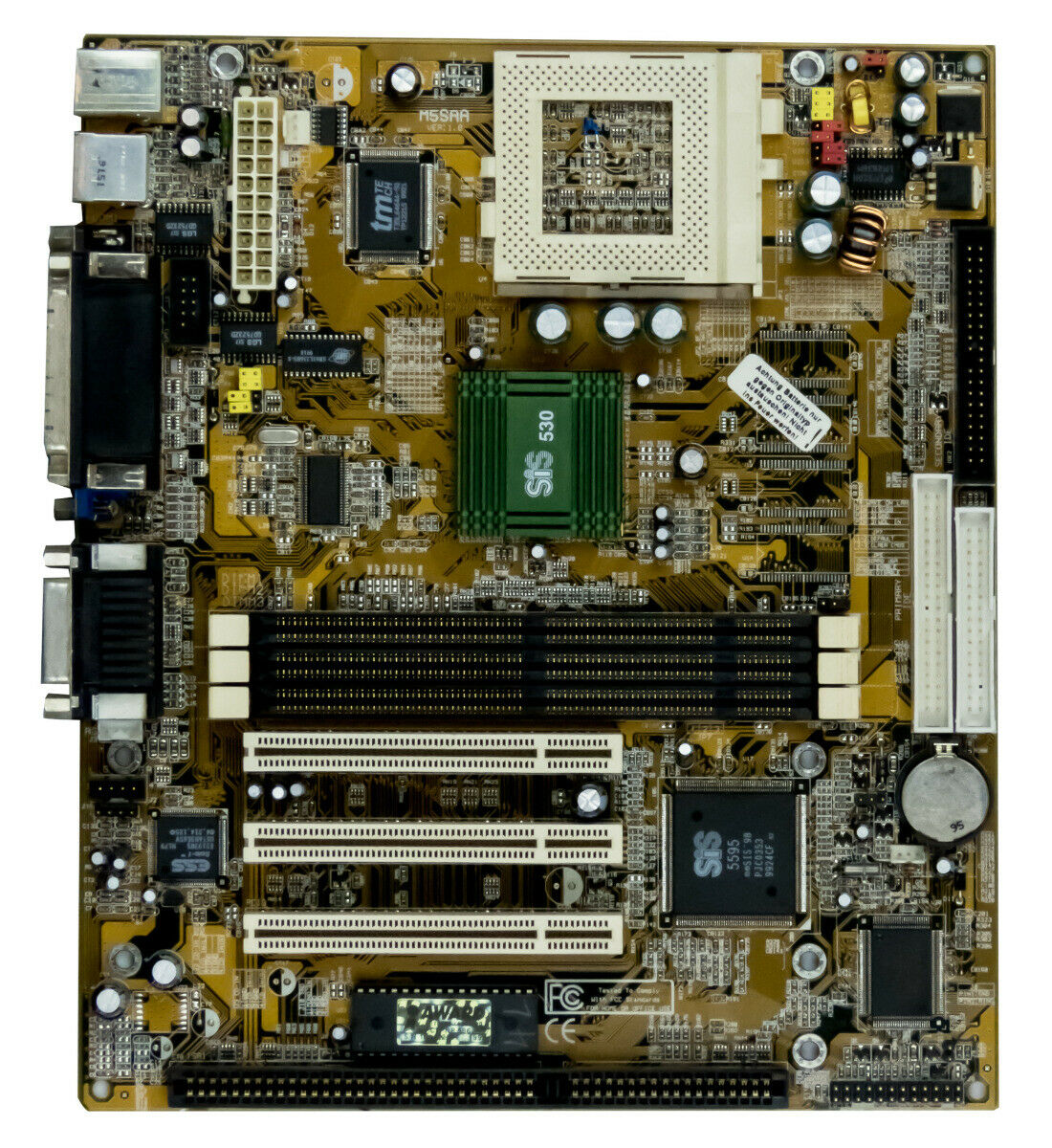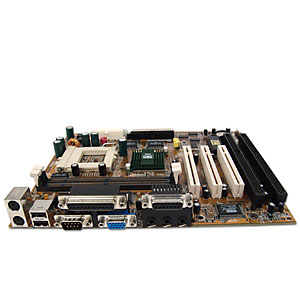 Biostar Motherboards
Biostar Motherboards
Biostar was a motherboard manufacturer for the IBM PC and its compatibles during the DOS era. They started in 1986, and are still in business today.
They were never considered "high end", but not the worst either.
MB-1212V
|
||||||
MB-1420/1425/1433V
|
||||||
|
| Hercules Dynamite 128 | 43 MB/sec |
| Matrox Millennium (MGA2064) | 43 MB/sec |
| Elsa Winner 1000 (S3 Trio64V+) | 43 MB/sec |
MB-8500SAC
Year: 1994
Type: Socket 7
Form Factor: Baby AT (280mm x 220mm)
Power Connector: AT
Chipset: SiS 5511
Slots: 3 x 16-bit ISA, 3 x PCI
Memory:
4 x 72-pin SIMM (EDO supported). Max 128 MB.
BIOS: Award
BIOS Dates: -
Known board revisions: v1.0
Supports Intel Pentium P54C/T, P55C/T, AMD K5 and Cyrix M1 CPUs from 75 MHz up to 180 MHz, with core voltages of 3.3V, 3.4V, 3.5V or 5V.
The MB-8500SAC comes with either 256 KB, 512 KB or 1 MB of onboard L2 cache in a single bank.
Some revisions of this board allow for a VGA D-type port or PS/2 mouse port to be installed at J6.
MB-8500TAC
Year: 1994
Type: Socket 7
Form Factor: Baby AT (275mm x 220mm)
Power Connector: AT
Chipset: Intel 430FX Triton
Slots: 4 x 16-bit ISA, 3 x PCI
Memory:
4 x 72-pin SIMM (EDO supported). Max 128 MB.
BIOS: American Megatrends
BIOS Dates: 10/10/94
Known board revisions: 1.0, 2.0, 3.0, 4.0, 5.0, and 6.0
Supports: Intel Pentium 66 up to 200 MHz (1.0x, 1.5x, 2.0x, 2.5x and 3.0x multipliers) on revisions 3.0 and earlier. On rev 4.0 are later, which added split-rail voltage, Cyrix 6x86 (M1) P120+, P133+, P150+ and P166+ CPUs and AMD K5 P75 to P100 are also supported. IDT C6 (WinChip 2) 200 and 240 are also supported on these later boards.
Explicitly *NOT* supported are Pentium MMX CPUs, AMD K6-2 and K6-III as well as Cyrix 6x86L/6x86MX/6x86MII, due to the non-supported core voltage options and the power plane is too weak to run them.
CPU voltage options are 2.5V up to 3.5V up to and including revision 5. Rev 6.0 only starts voltages from 2.8V.
Board revision 4 and later support a PCI bus speed of 27.5 MHz in addition to the 25, 30 and 33 MHz options.
The SIMM slots are in 2 banks.
The board comes with either 256 KB or 512 KB or onboard L2 write-back cache over 2 banks + 1 TAG RAM chip. This supports both asynchronous mix mode SRAM and synchronous pipeline burst SRAM.
 MB-8500TEC
MB-8500TEC
Year: 1994
Type: Socket 7
Form Factor: Baby AT (275mm x 220mm)
Power Connector: AT
Chipset:
Slots:
Memory:
BIOS:
BIOS Dates:
Known board revisions: 3
MB-8500TVX-A (TVX0909A, TVX0607B)
(TVX0909A, TVX0607B)
Year: 1995
Type: Socket 7
Form Factor: Baby AT (220mm x 220mm)
Power Connector: AT
Chipset: Intel 430VX
Slots: 4 x 16-bit ISA, 3 x PCI
Memory:
4 x 72-pin SIMM (EDO supported). Max 128 MB.
BIOS: AMI HiFlex v1.07
BIOS Strings:
51-0407-001223-00111111-071595-82430VX-F
51-0607-001223-00111111-071595-82430VX-F
BIOS Dates: 07/15/95
Known board revisions: 1.1, v2.1, v2.2, v2.3, v4.0
CPU support: Intel Pentium P54C/T and P55C/T, AMD K5, and Cyrix M1, MII.
CPU clock speeds range from 75 MHz up to 200 MHz.
CPU voltage selections are 3.4V or 3.5V for single voltage, and for dual rail V-core of 2.6V or 2.9V.
The board comes with either 256 KB or 512 KB or L2 cache onboard in a single bank with a TAG RAM chip.
TVX comes with a PS/2 keyboard socket. TVX-A has some revisions that come with an AT-style keyboard socket.
Revisions older than 2.3 can only run Pentium MMX or Cyrix MII up to 166 MHz (classic Pentium 200 is fine). Revisions from 2.3 and higher support the MMX and MII CPUs up to their maximum 200 or 233 MHz (3.0x or 3.5x multiplier).
M5ALA
Year: April 1998
Type: Super Socket 7
Form Factor: ATX (305mm x 200mm)
Power Connector: ATX
Keyboard Connector: PS/2
Chipset: ALi Aladdin V.
Slots: 2 x ISA (16-bit), 4 x PCI, 1 x AGP (2x).
Memory: 3 x 168-pin DIMM (SDR 100 MHz only). 512 MB max.
BIOS: Award
BIOS Dates:
01/07/1998 (only for use on rev 1.1 boards) - Added "AMD K6-2 msg", Support Cyrix MII CPUs.
11/08/1998 (only for use on rev 1.1 boards) - Support 95 MHz clock CPU.
13/10/1998 - Added green LED, added fan power off in green mode.
03/11/1998 - Supports AMD K6-2 380/400 MHz
04/04/1999 - Added K6-2 and K6-III 450, Cyrix 350/366 MHz
24/05/1999
05/11/1999 - Added support for AMD K6-2 500 MHz.
28/12/1999
- Fixed boot problem with Intel 233 MHz CPUs.
Latest BIOS Version: ALA1105B.
Known Board Revisions: 1.0, 1.1, 2.0
512 KB Level 2 pipeline burst SRAM cache onboard.
Supports Intel Pentium and Pentium MMX, IDT C6 "Centaur" 180/200 MHz, Cyrix 6x86, Cyrix MII, AMD K5, AMD K6, K6-2 and K6-III CPUs. Core voltages from 2.1V up to 3.3V.
CPU Speeds from 120 MHz up to 333 MHz.
The board has a built-in switch mode voltage regulator for better efficiency with Intel MMX, AMD K6 and Cyrix/IBM MX processors.
This motherboard often had its chipset relabelled to "Super TX", but is in fact an ALi M1541 (Aladdin V).
M5ATA
Year: 1997
Type: Socket 7
Form Factor: AT
Chipset: ALI Aladdin IV+
Slots: 3 x ISA (16-bit), 4 x PCI
Memory: 4 x 72-pin SIMM, 2 x 168-pin DIMM, 256 MB max.
BIOS: Award 4.51PG
Known Revisions: 1.0
512 KB L2 cache onboard.
Onboard voltage regulator is capable of providing between 1.3V and 3.5V, though core voltage settings permitted are 2.8V up to 3.5V.
BIOS file ata1125b.exe works best (even if it's not necessarily the latest) if you want support for AMD K6-III, though you will need to make some alterations if you want this board to support 2.4V.
Supports FSB speed up to 75 MHz.
CPU clock multipliers up to 3.5x.
M5SAA
Year: 1999
Type: Socket 7
Form Factor: Micro ATX (245mm x 209mm)
Power Connector: ATX
Keyboard Connector: PS/2
Chipset: SiS 530
Slots: 1 x ISA (16-bit), 3 x PCI
Memory: 3 x 168-pin DIMM, max. 768 MB.
BIOS: Award
Known Revisions: 1.0
CPU Support:
Intel Pentium P54C and Pentium MMX 166-233 MHz.
Cyrix 6x86, 6x86L, 6x86MX, and MII
AMD K5, K6, K6-2 and K6-III
IDT Win 2A/, 3
Rise MP6
The front-side bus can be set from 66 MHz up to 100 MHz.
The board has an integrated 2D and 3D graphics accelerator supported resolutions up to 1600 x 1200. It uses up to 8 MB shared memory. The onboard audio (an ESS Solo 1) is capable of Sound Blaster 16/Pro compatibility as well as Windows Sound System, and has 100% native support for DOS gaming.
It comes with two onboard caches: L1 is 64 KB in size, and L2 is 1024 KB.
The three memory slots support up to 256 MB DIMMs, up to PC100 speed. They support both synchronous and asynchronous DRAMs.
Its two IDE connectors support PIO Mode 4, providing up to Ultra DMA-66 speeds.
The board also has two USB 1.0 ports.
M5SAB
Year: 1999
Type: Socket 7
Form Factor: Baby AT (213mm x 222mm)
Power Connector(s): AT and ATX
Keyboard Connector: AT
Chipset: SiS 530
Slots: 2 x 16-bit ISA, 4 x PCI
Memory: 3 x 168-pin DIMM, max. 768 MB.
BIOS: Award
Known Revisions: ?
CPU Support:
Intel Pentium P54C and Pentium MMX 166-233 MHz.
Cyrix 6x86, 6x86L, 6x86MX, and MII
AMD K5, K6, K6-2 and K6-III
IDT Win 2A/, 3
Rise MP6
The front-side bus can be set from 66 MHz up to 100 MHz.
Onboard L2 cache is up to 1024 KB of pipeline burst SRAM.
The board has an integrated 2D and 3D graphics accelerator supported resolutions up to 1600 x 1200. It uses up to 8 MB shared memory. Unlike the later M5SAA, the M5SAB does not have onboard audio.
The DIMM slots support unbuffered synchronous DRAM.
Its two IDE connectors support PIO Mode 4, providing up to Ultra DMA-66 speeds.
The board also has two USB 1.0 ports.
M5SIB
Year: 1997
Type: Socket 7
Form Factor: Micro-ATX
Chipset: SiS 5598
Slots: 2 x 16-bit ISA, 3 x PCI
Memory: 2 x 168-pin DIMM (up to 256 MB max).
BIOS: Award
Known Revisions: v2.0
Supports Intel Pentium P54C/P55C 90 - 233 MHz (MMX), Cyrix MII, AMD K6 266 MHz, and AMD K6-2 CPUs (300 - 333 MHz).
Memory support is for PC66 or PC100 SDRAM using 8, 16, 32, 64, or 128 MB of 60ns 3.5V or faster EDO SDRAM DIMMs. It does not accept parity (36-pin) DIMMs. The board has no configuration jumpers - the BIOS auto-detects memory installed and its type.
It has 512 KB of L2 cache (pipeline burst cache) - it is not upgradable.
The motherboard has onboard audio via ESS ES1869, as well as integrated video with 4 MB video memory (shared with main memory).
This was the mainboard sold with the Packard-Bell Pegasus (PB992) PC.
M5VNB
Year: 2000
Type: Super Socket 7
Form Factor: AT (230mm x 220mm)
Power Connector: ATX and AT
Chipset: VIA MVP4
Slots: 1 x ISA (16-bit), 3 x PCI
Memory: 3 x 168-pin DIMM, max. 768 MB.
BIOS: Award
Known Revisions: -
CPU Support:
Intel Pentium P54C and Pentium MMX 166-233 MHz.
Cyrix 6x86, 6x86L, 6x86MX, and MII
AMD K6 and K6-2
IDT Centaur C6
Rise MP6
CPU core voltages supported are 2.1V up to 3.5V, with 1.5x up to 5.5x CPU/host multiplier.
The M5VNB get either 512 KB or 1024 KB of onboard L2 cache.
It supports either 66 or 100 MHz front-side bus. There is also an odd 105 MHz option which drives the PCI slots at 35 MHz instead of their normal 33 MHz.
Memory support is up to PC100 unbuffered SDRAM in 8 MB, 16 MB, 32 MB, 64 MB, 128 MB or 256 MB DIMM modules.
The M5VNB comes with onboard 2D and 3D video acceleration with up to 8 MB shared memory - this is understood to be made by Trident. This is AGP 2.0-compliant (1x and 2x). It also comes with onboard audio that is AC'97 DirectSound-compliant. It supports hardware Sound Blaster Pro via either a Windows DOS box and "hardware-assisted FM synthesis for legacy compatibility".
The IDE ports provide PIO Modes 0-4, up to Ultra-DMA 66 performance.


